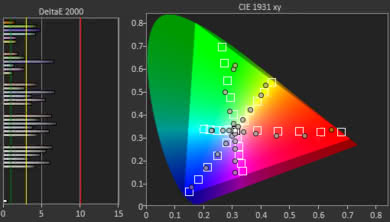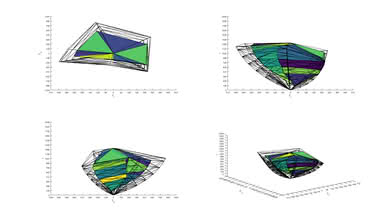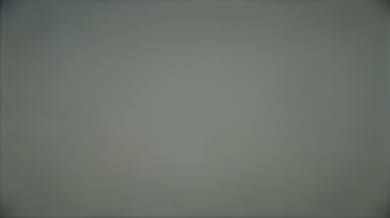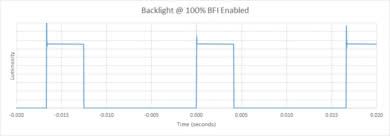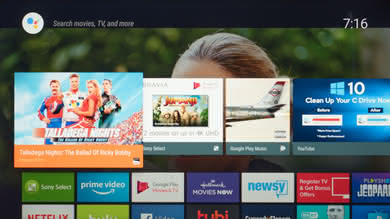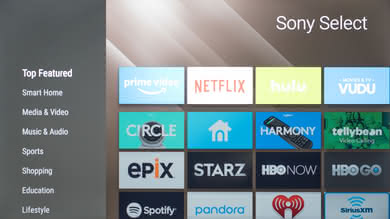Our Verdict
This is a decent TV for mixed usage. Its viewing angles allow you to watch it from the side so it is a TV that you can place in a wide room. It does not have deep blacks so it is not suitable for a dark room but rather for an average lit room where lights are not directly facing the screen. It will perform better when watching sports or TV shows or playing a casual game.
- Excellent out of the box color accuracy
- Good gray uniformity
- Blacks look grayish in a dark room
- Poor HDR performance
This is a mediocre TV for watching movies in a dark room. Blacks look gray as the TV's contrast ratio is disappointing and the 24p judder removal feature will not work well from external players that send 60p or 60i signals. Motion handling is decent and fast motion will look smooth, but the limited color gamut does not allow the TV to produce rich, saturated colors to improve picture quality.
This is a good TV for watching TV shows. You can easily place it in an average lit room and you do not have to watch from straight in front to enjoy the same picture quality. It has a motion interpolation feature for the fans of the soap opera effect. This TV is a good choice if you will spend most of your time watching TV shows.
The Sony X750F is a good TV for watching sports. You can place it in a large fairly bright room and you can invite your friends to watch your favorite team play. It has wide viewing angles, good reflection handling and a fast response time that displays fast motion smoothly. Gray uniformity is good so you will not notice any dirty screen effect and the cable signal is upscaled well so that you enjoy every little detail of the pitch.
The Sony X750F performs well in video games. It has a low input lag and feels very responsive to your inputs. Its response time is fast, so fast action scenes look smooth. Unfortunately, if you play in a dark room, blacks will look grayish due to the sub-par contrast ratio. The TV does not support any of the more advanced gaming features like VRR, but this will not be an issue if you are a casual gamer.
This is a mediocre TV for watching HDR Movies. The contrast ratio is low, and blacks look gray in a dark room where HDR is meant to be watched. The brightness level is not enough, and the limited color gamut is not allowing you to enjoy a rich and saturated image that depicts the directors intent. If HDR movies are what you are looking for, this TV should not be at the top of your list.
The HDR gaming performance of this TV is decent. This is mainly due to the low input lag the TV has on 4k @ 60Hz + HDR signal, and the fast response time. Unfortunately, the contrast ratio is low and the color gamut is limited so HDR performance is not good and the picture quality is not what the game director intended.
This is a good TV for use as a PC monitor. The viewing angles are decent and thus you will not have any uniformity issues if you sit close. The response time is good so only a small trail will follow your mouse movements and the TV will feel very responsive due to the low input lag. Reflections are also good and the TV is capable of displaying clear and crisp text.
Changelog
- Updated Jul 23, 2020: In accordance with our current testing methodology, the backlight is now considered flicker-free.
- Updated May 21, 2020: Converted to Test Bench 1.5.
- Updated Feb 21, 2020: Converted to Test Bench 1.4.
- Updated Mar 29, 2019: There was a mistake in the BFI scoring. We have corrected it.
Check Price
Differences Between Sizes And Variants
We tested the 55" (KD55X750F). For the most part, we expect our review to be valid for the 65" model (KD65X750F), and the 43" and 49" models currently available in Canada and the UK. The UK variant of the TV is also known as the Sony XF75.
The 43" and 49" models have an external power adapter (brick), the 55" and 65" have it built-in.
If someone comes across a different type of panel or if their Sony X750F doesn't correspond to our review, let us know and we will update the review. Note that some tests such as the gray uniformity may vary between individual units.
| Size | US Model | Canada Model | UK Model | VESA Mount Size |
| 43" | KD-43X750F | KD-43XF7596 | 100x200 | |
| 49" | KD-49X750F | KD-49XF7596 | 200x200 | |
| 55" | KD55X750F | KD-55X750F | KD-55XF7596 | 200x200 |
| 65" | KD65X750F | KD-65X750F | KD-65XF7596 | 300x200 |
We have received reports that the 65" model has a VA panel. We don't know about the 43" and 49" models.
The TV we've tested was manufactured in June 2018.
Popular TV Comparisons
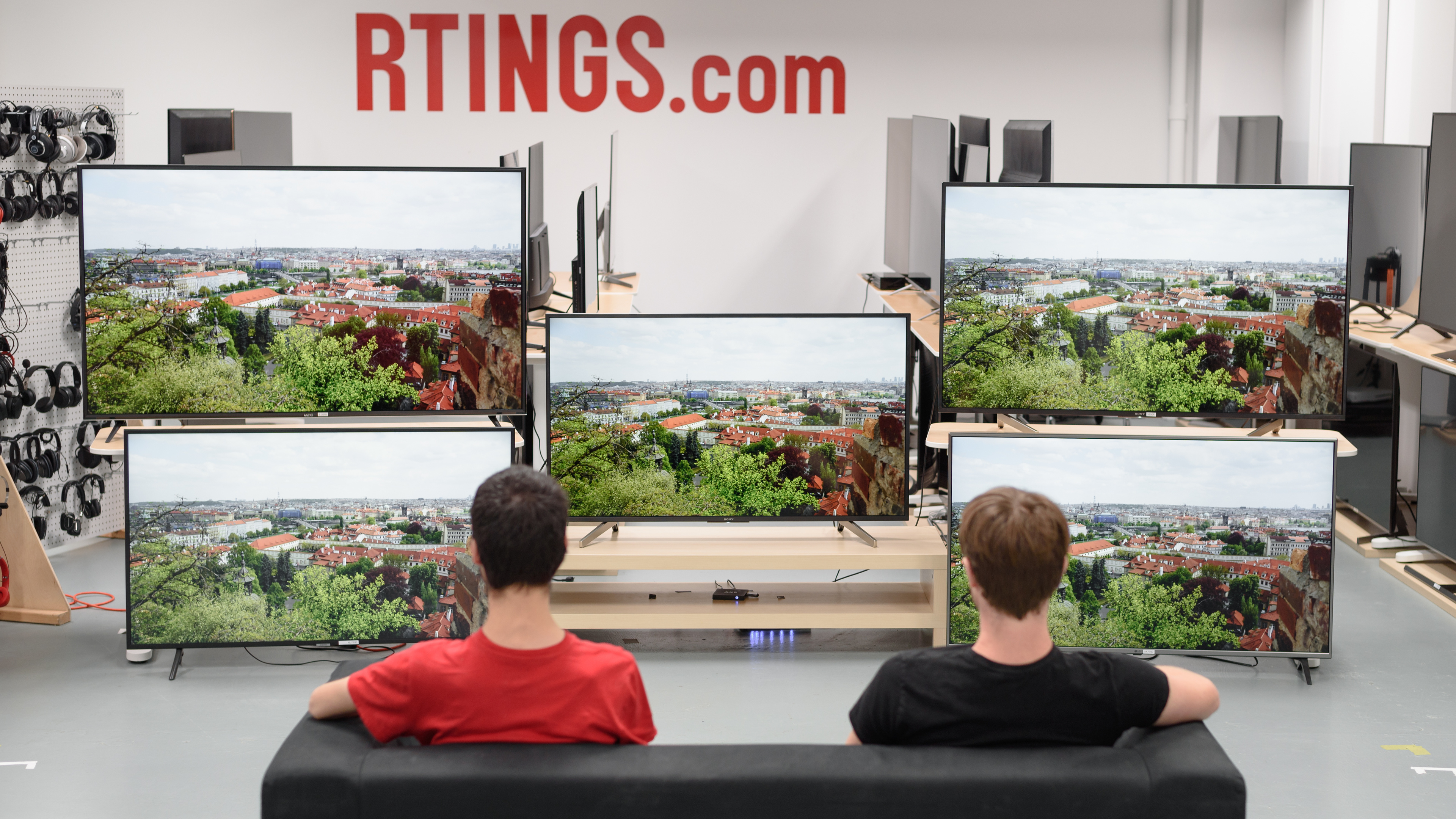
The Sony X750F is a decent TV that performs better for casual TV watching. See our recommendations for the best 4k TVs and the best TVs.
The Vizio M Series 2018 is much better than the Sony X750F. The Vizio can get brighter, has better blacks due to better contrast ratio and local dimming support, and offers a better movie experience in a dark room. The Vizio also has a lower input lag which you will appreciate if you play video games or use the TV as a PC monitor. On the other hand, the Sony X750F has better viewing angles for wide seating arrangements and a motion interpolation feature to please the soap opera effect fans.
The Sony X750F is a bit better than the Sony X800E. The X750F has better reflection handling and is more suitable for a room with many small light sources. On the other hand, the Sony X800E can get brighter in SDR and can fight bright room glare and has a wider color gamut. If you wish to eliminate blur and make the image crisper, the X750F has a much better BFI performance and can insert 60Hz flicker to do that.
The Sony X850F is better than the Sony X750F. The Sony X850F can get brighter and has better reflection handling, so you can place it in a brighter room without issues. The Sony X850F also has a faster response time, can remove 24p judder, and has a motion interpolation feature. Finally, the X850F has a lower input lag, which is great for video games. The Sony X750F, on the other hand, has better color accuracy out of the box.
These two TVs have different panel types. If you have a room with a wide seating arrangement, then the Sony X750F might be the better choice as the image remains accurate when viewed from the side. In most other cases, however, the Sony X900F seems to be the better choice. The X900F has much better dark room performance and can get much brighter both in SDR and in HDR. The X900F has better motion handling, and the image is crisp with minimal blur trail thanks to the faster response time. The X900F has better reflection handling and can remove 24p judder from any source.
Test Results
The design of the Sony X750F resembles very much the design of the Sony X830F. The stand supports the TV well and has a plain and sturdy design that allows for a soundbar to be placed in front (see our recommendations for the best soundbars). The stand also serves as the TVs cable management path as it routes the cables through its rear legs. The back of the TV is plain, and although the X750F is a little thick, it will not protrude much if wall mounted. The build quality is good and at par with most Sonys.
The stand of the X750F is a blend. It is fully plastic but the front part of each leg has a metallic tint whereas the rear part is black and has a channel to route cables. Unlike the X830F, you can not reverse the legs so that the front becomes back, nor can you switch the left leg with the right one. The stand supports the TV well but does not prevent wobbling. It is almost as wide as the TV itself so you will need a wide table.
Footprint of the 55" TV stand: 39.8" x 13.6"
The back is plastic and resembles a lot the back of the X830F but it has a little bulkier feel. Cable management is well thought of as cables can be routed through the legs of the stand. However, if you wall-mount the TV, you might have some difficulty accessing some of the ports.
Update 09/21/2018: We've heard reports that the 65" model has a VA panel. We haven't confirmed this, but if so we expect it to have a higher contrast ratio (3000:1 or more) but poor viewing angles.
The native contrast ratio is disappointing. This is expected from an IPS panel and the result is very similar to the higher end model X850F.
The Sony KD55X750F does not support local dimming. The video is for reference only.
Decent SDR peak brightness. The TV cannot get bright enough to fight glare and thus it is not suitable for a very bright room. The good news is that the brightness level remains constant regardless of the window size.
Decent HDR peak brightness for the X750F. It cannot get as bright as X900F, or the even X850F but the brightness level remains constant as the window size increases.
If you find HDR content too dim, see our recommended settings.
The overall gray uniformity of the X750F is good. Very similar to the other Sony models from the last two years. The results of the 50% gray is a little worse than the 5% gray. You can notice the sides and the corners of the screen that are darker than the center. The good news is that there is not much dirty screen effect visible, and thus sports will look good.
Update 09/21/2018: We've heard reports that the 65" model has a VA panel. We haven't confirmed this, but if so we expect it to have a higher contrast ratio (3000:1 or more) but poor viewing angles.
Decent viewing angles. The image remains fairly constant as you view it from a fairly wide angle. The result is on par with other IPS sony models like the X800E and X850F but is slightly worse than last year's X720E.
Disappointing black uniformity for the Sony KD55X750F. There is clouding scattered around the screen and obvious backlight bleed in the bottom and top sides of the screen. Very comparable results to the higher end model X850F.
Excellent out of the box color accuracy of the Sony X750F. This accuracy is very close to that of the X900F and much better than the X830F or the X850F. Most people will be satisfied with this TV out of the box and the TV won't benefit much from a professional calibration.
'Custom' is the most accurate picture mode out of the box with white balance dE and Color dE at very low levels, and most people will not notice any inaccuracies. Gamma is spot on our target of 2.2. The gamma curve is followed quite accurately until the higher input levels where the TV is slightly brighter than our stimulus.
Excellent results after calibration for the X750F. The gray inaccuracies almost disappeared although the color inaccuracies were not improved.
Overall, the calibration was able to improve the accuracy only slightly, as the TV was already very accurate out of the box. Also, the color dE could not be diminished because Sony TVs do not have a color management system. Unfortunately, the final result is not as accurate as the X850E or the X830F.
You can see our recommended settings here.
Most IPS monitors have a chevron shaped pixel layout, but this one is different. The last time we found an IPS monitor whose pixel shape did not resemble the chevron shape was when we reviewed the Sony W600D.
The HDR color gamut of the X750F is decent. The Rec 2020 coverage, however, is limited and does not meet our threshold for a wide color gamut TV. In very colorful scenes the TV's limited color gamut will be noticeable.
The HDR EOTF in 'Custom' picture mode with Contrast at 90 follows the target PQ quite well. The results in the 'Game' picture mode and in 'PC' picture mode are almost identical.
If you raise contrast to 'max' you can get a slightly brighter image but with a more abrupt clipping of the brighter highlights, as shown in this plot.
The low contrast ratio and the limited color gamut do not allow it to have a good color volume result. Thus its performance in this test is sub-par and the worst among this year's Sonys that we've tested.
The gradient of the Sony X750F is great. Gray is excellent as with most Sonys, but there is some banding in the other colors.
Even if you do notice a case of major banding that bothers you, you can use Random noise reduction for analog (film) or Digital noise reduction for older digital content to reduce it, but this can result in a loss of some fine details.
We don't expect IPS panels to experience permanent image retention, as the IPS panel in our long-term test appears immune.
Great fast response time for this KD55X750F, although slower than X850F. The response time allows for a small blur trail as you can see in the motion blur picture.
Update 07/23/2020: Following our current testing methodology, the backlight is now considered flicker-free. The small amount of flicker measured is simply noise.
The TV has no visible flicker in its backlight as it dims, which is great as it makes motion look smoother.
We did measure some flicker with our photodiode tool, but this will not be visible in person even at the lowest brightness settings.
Update 03/29/2019: The 120Hz for 120 fps was scored incorrectly. The score has increased.
The Sony X750F supports black frame insertion only at 60Hz. This feature can help clear up blur by flickering the backlight and thus removing persistence blur. To do so set Motionflow to 'Custom' and increase the 'Clearness' slider.
The Sony X750F has a 60Hz panel which can interpolate lower frame rate content up to 60p. To enable interpolation, set Motionflow to 'Custom' and increase the 'Smoothness' slider to your liking. Any motion interpolation introduces artifacts, so unless you really like the soap opera effect, use it with caution.
Very good stutter performance. Although the response time is fast to allow for a quick transition there is some blur which helps to smooth the transition in low frame rate content.
The TV can automatically remove 24p judder from older movies. Unfortunately, it cannot remove the 24p judder if it is found within a 60p or 60i signal or within the Native Apps. If judder is really an issue you can set Motionfllow to 'Smooth' and Cinemotion to 'Auto'. This will help remove judder, but it will add some motion interpolation
The Sony X750F does not support variable refresh rate, and thus can not improve game performance by removing tearing.
The Sony KD55X750F has a great low input lag which will keep most casual gamers happy. To obtain the lowest possible input lag make sure you are in 'Game' or 'Graphics' mode.
The X750F, just like the X850F, supports most common input signals but no 120Hz.
To properly display chroma 4:4:4, the Picture mode must be set to 'Graphics' or 'Game'. When the TV is sent a 1080p signal in 'Graphics' mode, the upscaling changes to the jagged nearest-neighbor upscaling type, seen here on the X900E, that some people prefer for PC use.
Only HDMI ports 2 and 3 support HDMI full bandwidth, so 4k @ 60Hz @ 4:4:4 or 4:2:2 is only possible on these two ports and only when Enhanced format is enabled on the TV.
Sharpness 50 (default) means no added sharpness in Graphics mode.
The frequency response of the X750F is mediocre-at-best. The LFE (low-frequency extension) of 127Hz indicates a bass that produces no thump, rumble, or punch, which is common to bass-heavy film scores and video game sound effects. However, the bump around 200Hz compensates for this lack somewhat, by making the sound a bit fuller. The response above 200Hz is very good and even, which is important for producing clear and intelligible dialog. Additionally, this TV gets pretty loud, without producing too much compression and pumping artifacts.
The distortion performance of the X750F is sub-par. The overall amount of THD produced at 80dB SPL is within decent limits, however like most other Sony TVs, there is a big jump in THD under maximum load. But this won't be very noticeable in real-life situations.
The interface of the X750F is decent. The TV runs the Android TV interface which is intuitive but crowded and some might not find pleasant to use. The home screen is long and it can take a lot of scrolling before you reach to the menu item you want. Just like the X830F, the interface has an inconsistent behavior where sometimes it is fast, and other times it lags and animations become choppy. The home menu does not respond quickly and this is unfortunate considering its use frequency. The good news is that there are many buttons on the remote that allow you to navigate quickly where you want, and the voice control feature that can also help.
The Sony KD55X750F does not have ads. There is suggested content by default just like the other 2018 Sony TVs we tested, but that can be disabled in the TV's Home settings.
The Sony X750F includes the same remote as the X850F. It has more buttons than most remotes and is quite large, but with good usability. Buttons are easy to find and it doesn't take long to access most basic functions of the TV.
The included voice button works well to access Google Assistant, but the remote must be connected to the TV via Bluetooth for this to work. Google Assistant can perform most basic actions on the TV, such as changing inputs or opening certain apps. More advanced functions such as changing picture settings do not work.



























